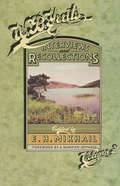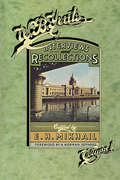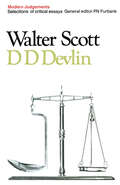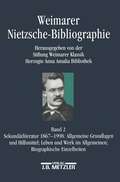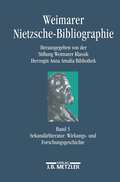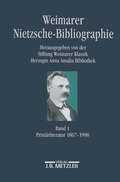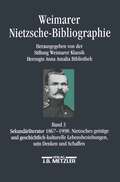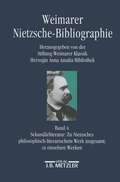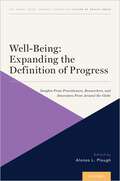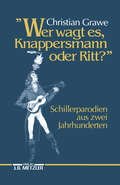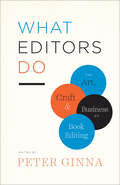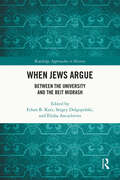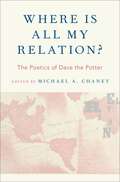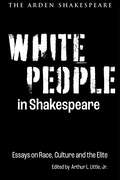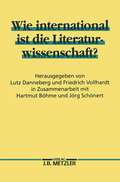- Table View
- List View
Wallace Stevens In Theory (Liverpool English Texts and Studies #101)
The modernist poetry of Wallace Stevens is replete with moments of theorizing. Stevens regarded poetry as an abstract medium through which to think about and theorize not only philosophical concepts like metaphor and reality, but also a unifying thesis about the nature of poetry itself. At the same time, literary theorists and philosophers have often turned to Stevens as a canonical reference point and influence. In the centenary year of Wallace Stevens’s first collection Harmonium (1923), this collection asks what it means to theorize with Stevens today. Through a range of critical and theoretical perspectives, this book seeks to describe the myriad kinds of thinking sponsored by Stevens’s poetry and explores how contemporary literary theory might be invigorated through readings of Stevens.
Walter Besant: The Business of Literature and the Pleasures of Reform (Liverpool English Texts and Studies #76)
In the 1880s and 1890s, Walter Besant was one of Britain’s most lionized living novelists. Like many popular writers of the period, Besant suffered from years of critical neglect. Yet his centrality to Victorian society and culture all but ensured a revival of interest. While literary critics are now rediscovering the more than forty works of fiction that he penned or co-wrote, as part of a more general revaluation of Victorian popular literature, legal scholars have argued that Besant, by advocating for copyright reform, played a crucial role in consolidating a notion of literary property as the exclusive possession of the individuated intellect. For their part, historians have recently shown how Besant – as a prominent philanthropist who campaigned for the cultural vitalization of impoverished areas in east and south London – galvanized late Victorian social reform activities. The expanding corpus of work on Besant, however, has largely kept the domains of authorship and activism, which he perceived as interrelated, conceptually distinct. Analysing the mutually constitutive interplay in Besant’s career between philanthropy and the professionalization of authorship, Walter Besant: The Business of Literature and the Pleasures of Reform highlights their fundamental interconnectedness in this Victorian intellectual polymath’s life and work.
Walter de la Mare: Critical Appraisals (Liverpool English Texts and Studies #95)
This book aims to put Walter de la Mare back on the literary map. A writer beloved by many, he has nevertheless remained on the sidelines of literary history. Walter de la Mare: Critical Appraisals promises to restore his reputation as one of the most memorably haunting of poets, as well as a peculiarly unnerving writer of ghost stories. A collection of varied, wide-ranging essays on de la Mare’s poetry, stories, novels, reviews and lectures, it puts his work beside that of many of his famous contemporaries, including Thomas Hardy, Robert Frost, W. H. Auden, T. S. Eliot and Katherine Mansfield. It also contains an invaluable survey of his archive, much of it unpublished, and a number of newly commissioned poems reflecting on his legacy. This multifaceted volume will be of interest to students working on twentieth-century poetry, the short story, the nature and limits of modernism and British intellectual history, as well as on de la Mare himself.List of contributors: Catherine Charlwood, Guy Cuthbertson, Peter Davidson, Giles de la Mare, Andrew Doyle, Suzannah V. Evans, Adam Guy, Robin Holloway, Yui Kajita, Zaffar Kunial, Gregory Leadbetter, Angela Leighton, Erica McAlpine, Jenny McDonnell, Will May, Andrew Motion, Paul Muldoon, A. J. Nickerson, Seamus Perry, Adrian Poole, Camille Ralphs, Vidyan Ravinthiran, Peter Scupham, A. E. Stallings, Mark Valentine, Rory Waterman, Anne Welsh, David Wheatley, Rowan Williams, William Wootten.
Walter Höllerer: Poetologische und literaturgeschichtliche Schriften 1952–1986
Walter Höllerer (1922–2003) gestaltete als Mitglied der Gruppe 47 und langjähriger Mitherausgeber der Zeitschrift Akzente maßgeblich die Modernisierung der deutschen Literatur in der zweiten Hälfte des 20. Jahrhunderts. Er gründete das Institut und die Zeitschrift Sprache im technischen Zeitalter sowie das Literarische Colloquium Berlin, gab wegweisende Anthologien wie Transit oder Junge amerikanische Lyrik heraus und organisierte Veranstaltungen, die den modernen Literaturbetrieb prägten. Seinen Schriften lassen sich zentrale Veränderungen des Literaturbegriffs im Übergang von der Nachkriegs- zur Gegenwartsliteratur ablesen. Anlässlich seines 100. Geburtstages und 20. Todestages präsentiert die Edition eine Auswahl der poetologischen und literaturgeschichtlichen Texte Walter Höllerers.
Weimarer Nietzsche-Bibliographie in 5 Bänden: Band 2: Sekundärliteratur 1867-1998: Allgemeine Grundlagen und Hilfsmittel; Leben und Werke im Allgemeinen; Biographische Einzelheiten
Die Weimarer Nietzsche-Bibliographie erfasst die zwischen 1867 und 1998 erschienene Primär- und Sekundärliteratur aller Sprachen und Länder. Ziel ist es, ein zuverlässiges bibliographisches Grundlagenwerk zu Leben, Werk und Wirkung Nietzsches für die internationale Einzelforschung und darüber hinaus für die Geisteswissenschaften insgesamt zu schaffen. Angestrebt wird ein hoher Grad an Vollständigkeit. Bei der Verzeichnung der Sekundärliteratur wird neben der eigentlichen Forschungsliteratur besonderes Augenmerk auf die Literatur zur Wirkungsgeschichte gelegt. Die Titelbeschreibung erfolgt weitgehend aufgrund der vorliegenden Originalquelle. An der Herzogin Anna Amalia Bibliothek ist mit der Privatbibliothek Friedrich Nietzsches und mit der Bibliothek des Nietzsche-Archivs, das bis 1945 seine Wirkungsstätte in Weimar hatte, ein Grundbestand der Nietzsche-Literatur vorhanden, der seit 1990 systematisch ausgebaut wird. Auf diesem Bestand konnte das Projekt einer umfassenden retrospektiven Personalbibliographie zu Friedrich Nietzsche aufbauen. Die Bibliographie erschließt die Literatur systematisch über Annotationen sowie über Register (Personen-, Sach- und Werkregister). Das Werk erscheint in fünf Bänden. Band 1 liegt bereits vor. Die übrigen vier Bände mit der Forschungsliteratur und der Literatur zur Wirkungsgeschichte folgen im April 2002. Insgesamt werden über 20.000 Dokumente verzeichnet. Die Weimarer Nietzsche-Bibliographie bildet die Plattform für jede Beschäftigung mit der internationalen Wirkung Nietzsches.
Weimarer Nietzsche-Bibliographie in 5 Bänden: Band 5: Sekundärliteratur: Wirkungs- und Forschungsgeschichte
Die Weimarer Nietzsche-Bibliographie erfasst die zwischen 1867 und 1998 erschienene Primär- und Sekundärliteratur aller Sprachen und Länder. Ziel ist es, ein zuverlässiges bibliographisches Grundlagenwerk zu Leben, Werk und Wirkung Nietzsches für die internationale Einzelforschung und darüber hinaus für die Geisteswissenschaften insgesamt zu schaffen. Angestrebt wird ein hoher Grad an Vollständigkeit. Bei der Verzeichnung der Sekundärliteratur wird neben der eigentlichen Forschungsliteratur besonderes Augenmerk auf die Literatur zur Wirkungsgeschichte gelegt. Die Titelbeschreibung erfolgt weitgehend aufgrund der vorliegenden Originalquelle. An der Herzogin Anna Amalia Bibliothek ist mit der Privatbibliothek Friedrich Nietzsches und mit der Bibliothek des Nietzsche-Archivs, das bis 1945 seine Wirkungsstätte in Weimar hatte, ein Grundbestand der Nietzsche-Literatur vorhanden, der seit 1990 systematisch ausgebaut wird. Auf diesem Bestand konnte das Projekt einer umfassenden retrospektiven Personalbibliographie zu Friedrich Nietzsche aufbauen. Die Bibliographie erschließt die Literatur systematisch über Annotationen sowie über Register (Personen-, Sach- und Werkregister). Das Werk erscheint in fünf Bänden. Band 1 liegt bereits vor. Die übrigen vier Bände mit der Forschungsliteratur und der Literatur zur Wirkungsgeschichte folgen im April 2002. Insgesamt werden über 20.000 Dokumente verzeichnet. Die Weimarer Nietzsche-Bibliographie bildet die Plattform für jede Beschäftigung mit der internationalen Wirkung Nietzsches.
Weimarer Nietzsche-Bibliographie in 5 Bänden: Band 1: Primärliteratur 1867-1998
Die Weimarer Nietzsche-Bibliographie erfasst die zwischen 1867 und 1998 erschienene Primär- und Sekundärliteratur aller Sprachen und Länder. Ziel ist es, ein zuverlässiges bibliographisches Grundlagenwerk zu Leben, Werk und Wirkung Nietzsches für die internationale Einzelforschung und darüber hinaus für die Geisteswissenschaften insgesamt zu schaffen. Angestrebt wird ein hoher Grad an Vollständigkeit. Bei der Verzeichnung der Sekundärliteratur wird neben der eigentlichen Forschungsliteratur besonderes Augenmerk auf die Literatur zur Wirkungsgeschichte gelegt. Die Titelbeschreibung erfolgt weitgehend aufgrund der vorliegenden Originalquelle. An der Herzogin Anna Amalia Bibliothek ist mit der Privatbibliothek Friedrich Nietzsches und mit der Bibliothek des Nietzsche-Archivs, das bis 1945 seine Wirkungsstätte in Weimar hatte, ein Grundbestand der Nietzsche-Literatur vorhanden, der seit 1990 systematisch ausgebaut wird. Auf diesem Bestand konnte das Projekt einer umfassenden retrospektiven Personalbibliographie zu Friedrich Nietzsche aufbauen. Die Bibliographie erschließt die Literatur systematisch über Annotationen sowie über Register (Personen-, Sach- und Werkregister). Das Werk erscheint in fünf Bänden. Band 1 liegt bereits vor. Die übrigen vier Bände mit der Forschungsliteratur und der Literatur zur Wirkungsgeschichte folgen im April 2002. Insgesamt werden über 20.000 Dokumente verzeichnet. Die Weimarer Nietzsche-Bibliographie bildet die Plattform für jede Beschäftigung mit der internationalen Wirkung Nietzsches.
Weimarer Nietzsche-Bibliographie in 5 Bänden: Band 3: Sekundärliteratur 1867-1998: Nietzsches geistige und geschichtskulturelle Lebensbeziehung, sein Denken und Schaffen
Die Weimarer Nietzsche-Bibliographie erfasst die zwischen 1867 und 1998 erschienene Primär- und Sekundärliteratur aller Sprachen und Länder. Ziel ist es, ein zuverlässiges bibliographisches Grundlagenwerk zu Leben, Werk und Wirkung Nietzsches für die internationale Einzelforschung und darüber hinaus für die Geisteswissenschaften insgesamt zu schaffen. Angestrebt wird ein hoher Grad an Vollständigkeit. Bei der Verzeichnung der Sekundärliteratur wird neben der eigentlichen Forschungsliteratur besonderes Augenmerk auf die Literatur zur Wirkungsgeschichte gelegt. Die Titelbeschreibung erfolgt weitgehend aufgrund der vorliegenden Originalquelle. An der Herzogin Anna Amalia Bibliothek ist mit der Privatbibliothek Friedrich Nietzsches und mit der Bibliothek des Nietzsche-Archivs, das bis 1945 seine Wirkungsstätte in Weimar hatte, ein Grundbestand der Nietzsche-Literatur vorhanden, der seit 1990 systematisch ausgebaut wird. Auf diesem Bestand konnte das Projekt einer umfassenden retrospektiven Personalbibliographie zu Friedrich Nietzsche aufbauen. Die Bibliographie erschließt die Literatur systematisch über Annotationen sowie über Register (Personen-, Sach- und Werkregister). Das Werk erscheint in fünf Bänden. Band 1 liegt bereits vor. Die übrigen vier Bände mit der Forschungsliteratur und der Literatur zur Wirkungsgeschichte folgen im April 2002. Insgesamt werden über 20.000 Dokumente verzeichnet. Die Weimarer Nietzsche-Bibliographie bildet die Plattform für jede Beschäftigung mit der internationalen Wirkung Nietzsches.
Weimarer Nietzsche-Bibliographie in 5 Bänden: Band 4: Sekundärliteratur: Zu Nietzsches philosophisch-literarischem Werk insgesamt; zu einzelnen Werken
Die Weimarer Nietzsche-Bibliographie erfasst die zwischen 1867 und 1998 erschienene Primär- und Sekundärliteratur aller Sprachen und Länder. Ziel ist es, ein zuverlässiges bibliographisches Grundlagenwerk zu Leben, Werk und Wirkung Nietzsches für die internationale Einzelforschung und darüber hinaus für die Geisteswissenschaften insgesamt zu schaffen. Angestrebt wird ein hoher Grad an Vollständigkeit. Bei der Verzeichnung der Sekundärliteratur wird neben der eigentlichen Forschungsliteratur besonderes Augenmerk auf die Literatur zur Wirkungsgeschichte gelegt. Die Titelbeschreibung erfolgt weitgehend aufgrund der vorliegenden Originalquelle. An der Herzogin Anna Amalia Bibliothek ist mit der Privatbibliothek Friedrich Nietzsches und mit der Bibliothek des Nietzsche-Archivs, das bis 1945 seine Wirkungsstätte in Weimar hatte, ein Grundbestand der Nietzsche-Literatur vorhanden, der seit 1990 systematisch ausgebaut wird. Auf diesem Bestand konnte das Projekt einer umfassenden retrospektiven Personalbibliographie zu Friedrich Nietzsche aufbauen. Die Bibliographie erschließt die Literatur systematisch über Annotationen sowie über Register (Personen-, Sach- und Werkregister). Das Werk erscheint in fünf Bänden. Band 1 liegt bereits vor. Die übrigen vier Bände mit der Forschungsliteratur und der Literatur zur Wirkungsgeschichte folgen im April 2002. Insgesamt werden über 20.000 Dokumente verzeichnet. Die Weimarer Nietzsche-Bibliographie bildet die Plattform für jede Beschäftigung mit der internationalen Wirkung Nietzsches.
Well-Being: Insights From Practitioners, Researchers, and Innovators From Around the Globe (Culture of Health)
Cities and countries around the world, from New Zealand to Singapore to Iceland, are starting to take a well-being approach by reorienting policies, budgets and other actions to advance human and planetary well-being. Well-being metrics--holistic measurements of an individual's or population's capacity to thrive, including the condition of their community, society, and environment--provide a nuanced and predictive view that transcends purely economic measures; they illuminate conditions of inequity and despair that other tools ignore, and expand the notion of health beyond simply the absence of disease. Well-Being: Expanding the Definition of Progress summarizes the experiences and insights of practitioners, researchers and innovators from around the world, gathered together by the Robert Wood Johnson Foundation to explore how a well-being approach might further spread in the United States. Centered in the commitment to balance economic growth--the traditional dashboard of progress--with well-being, this book is a combination of scientific papers, case studies from the field, and excerpts from a lively, multidisciplinary discussion which intentionally connects issues of measurement to the imperative for action. Rich with insights on policy and practice, narratives and culture, equity and shifts in power, alignment with other movements, and cross-sector collaboration, it is intended to inspire governmental leaders, policymakers, economists, measurement scientists, reporters, and others who crave a more integrated and balanced pursuit of progress.
"Wer wagt es, Knappersmann oder Ritt?": Schiller-Parodien aus zwei Jahrhunderten
70 Schillerparodien von 1789 bis zur Gegenwart, unter den Parodisten so bekannte Namen wie August Wilhelm Schlegel, Carl Maria von Weber, Heinrich Heine, Adolf Glaßbrenner, Robert Walser und Thorsten Becker: ein diebisches Lesevergnügen.
What Editors Do: The Art, Craft, and Business of Book Editing (Chicago Guides to Writing, Editing, and Publishing)
Editing is an invisible art where the very best work goes undetected. Editors strive to create books that are enlightening, seamless, and pleasurable to read, all while giving credit to the author. This makes it all the more difficult to truly understand the range of roles they inhabit while shepherding a project from concept to publication. In What Editors Do, Peter Ginna gathers essays from twenty-seven leading figures in book publishing about their work. Representing both large houses and small, and encompassing trade, textbook, academic, and children’s publishing, the contributors make the case for why editing remains a vital function to writers—and readers—everywhere. Ironically for an industry built on words, there has been a scarcity of written guidance on how to actually approach the work of editing. This book will serve as a compendium of professional advice and will be a resource both for those entering the profession (or already in it) and for those outside publishing who seek an understanding of it. It sheds light on how editors acquire books, what constitutes a strong author-editor relationship, and the editor’s vital role at each stage of the publishing process—a role that extends far beyond marking up the author’s text. This collection treats editing as both art and craft, and also as a career. It explores how editors balance passion against the economic realities of publishing. What Editors Do shows why, in the face of a rapidly changing publishing landscape, editors are more important than ever.
What Forms Can Do: The Work of Form in 20th- and 21st- Century French Literature and Thought (Contemporary French and Francophone Cultures #69)
This volume responds to important questions about the formal properties of literary texts and the agency of form. A central feature of twentieth- and twenty-first century French and Francophone writing has been the exploration of how cultural forms (literary, philosophical and visual) create distinctive semiotic environments and at the same time engage powerfully with external realities. How does form propose a bridge between the environment of the text and the world beyond? What kinds of formal innovations have authors devised in response to the complexity of that world? How do the formal properties of texts inflect our reading of them, and perhaps also our apprehension of the real? In addressing such questions as they apply to a wide corpus of texts, including the novel, life writing, the essay, travel writing, poetry and textual/visual experiments, the chapters in this volume offer new perspectives on a wide range of creative figures including Proust, Picasso, Breton, Bataille, Ponge, Guillevic, Certeau, Camus, Barthes, Perec, Roubaud, Chauvet, Savitzkaya, Eribon, Ernaux, Laurens and Akerman. Collectively, they renew the engagement with form that has been a key feature of French cultural production and of analysis in French studies.
What is Good Academic Writing?: Insights into Discipline-Specific Student Writing (New Perspectives for English for Academic Purposes)
The field of English for Academic Purposes (EAP) developed to address the needs of students whose mother tongue is not English. However, the linguistic competence required to achieve academic success at any university where English is the medium of instruction is a challenge for all students. While there are linguistic features common to academic literacy as a general genre, closer investigation reveals significant differences from one academic field to another. This volume asks what good writing is within specific disciplines, focussing on student work. Each chapter provides key insights by EAP professionals, based on their research in which they bring together analysis of student writing and interviews with subject specialists and markers who determine what 'good writing' is in their discipline. The volume includes chapters on established disciplines which have had less attention in the EAP and academic writing literature to date, including music, formal linguistics, and dentistry, as well as new and growing fields of study such as new media.
What’s Wrong with Antitheory?
Antitheory has long been a venerable brand of theory and – although seemingly opposite – the two impulses have long been intertwined. Antitheory is the first book to explore this vexed relationship from the 20th century to the present day, examining antitheory both in its historical context and its current state. The book brings together leading scholars from a wide range of Humanities disciplines to ask such questions as: · What is antitheory? · What does it mean to be against theory in the new millennium? · What is the current state of post-theory, the alleged deaths of theory, and the critique of critique?
When Jews Argue: Between the University and the Beit Midrash (Routledge Approaches to History)
This book re-thinks the relationship between the world of the traditional Jewish study hall (the Beit Midrash) and the academy: Can these two institutions overcome their vast differences? Should they attempt to do so? If not, what could two methods of study seen as diametrically opposed possibly learn from one another? How might they help each other reconceive their interrelationship, themselves, and the broader study of Jews and Judaism? This book begins with three distinct approaches to these challenges. The chapters then follow the approaches through an interdisciplinary series of pioneering case studies that reassess a range of topics including religion and pluralism in Jewish education; pain, sexual consent, and ethics in the Talmud; the place of reason and devotion among Jewish thinkers as diverse as Moses Mendelssohn, Jacob Taubes, Sarah Schenirer, Ibn Chiquitilla, Yair Ḥayim Bacharach, and the Rav Shagar; and Jewish law as a response to the post-Holocaust landscape. The authors are scholars of rabbinics, history, linguistics, philosophy, law, and education, many of whom also have traditional religious training or ordination. The result is a book designed for learned scholars, non-specialists, and students of varying backgrounds, and one that is sure to spark debate in the university, the Beit Midrash, and far beyond.
Where Is All My Relation?: The Poetics of Dave the Potter
Where Is All My Relation? presents the first sustained academic discussion of the poetry, pottery, and culture of David Drake, an antebellum slave who distinguished himself by composing verse on the ceramics he produced in the years leading up to the Civil War. During the 1830s, 40s, and 50s, he incised couplets and signatures (a singular "Dave") onto the incredibly large storage vessels that he made. In fact, his stoneware pots and jars are among the largest made in North America during the antebellum era, and craft enthusiasts and appraisers are still proclaiming their precision and ambitious volume. Rich with biblical allusions, historical facts, and personal opinions, his art provides unique insights into the lives of slaves, craftsmen, and the culture of the American South in the first half of the nineteenth century. The essays here engage with the historical context and major issues that Drake's work provokes, among them: prohibitions against slave literacy; Drake's privileged status compared to other slaves at the time; the interpretive status of his material craft objects; the influence of contemporary African American poet George Moses Horton; and Drake's ability to sell his pottery despite the fact that slaves were not officially permitted to participate in a cash economy. Featuring essays by literary critics, art-historians, archaeologists, and curators, Where Is All My Relation? provides a window into the world of nineteenth century material culture and expands our traditional understanding of the slave-narrative genre.
Where Words and Images Meet
Bringing together a fascinatingly diverse yet closely related group of subjects, Where Words and Images Meet asks us to rethink what we know about words and images and how they interact. From 19th-century frontispieces to Soviet photo albums, from the relationships between portraits and biographies to museum labels, the book's richly illustrated chapters open up historically specific connections between word and image to collective examination and fruitful analysis. Written by both established and emerging scholars in a range of interrelated fields, the chapters deliberately foreground previously overlooked topics as well as unfamiliar disciplinary approaches, to offer a stimulating and carefully developed framework for looking at these ubiquitous phenomena afresh. Where Words and Images Meet opens up for analysis and reflection the forms of attention, practices, skills and assumptions that underlie visual interpretation and meaning-making in the writing of history. By bringing the features of the materials we read and look at into focus, we can grasp more effectively the complex interrelationships involved, and enhance our practice and understanding.
White People in Shakespeare: Essays on Race, Culture and the Elite
What part did Shakespeare play in the construction of a 'white people' and how has his work been enlisted to define and bolster a white cultural and racial identity?Since the court of Queen Elizabeth I, through the early modern English theatre to the storming of the United States Capitol on 6 January 2021, white people have used Shakespeare to define their cultural and racial identity and authority. White People in Shakespeare unravels this complex cultural history to examine just how crucial Shakespeare's work was to the early modern development of whiteness as an embodied identity, as well as the institutional dissemination of a white Shakespeare in contemporary theatres, politics, classrooms and other key sites of culture. Featuring contributors from a wide range of disciplines, the collection moves across Shakespeare's plays and poetry and between the early modern and our own time to interrogate these relationships. Split into two parts, 'Shakespeare's White People' and 'White People's Shakespeare', it explores a variety of topics, ranging from the education of the white self in Hamlet, or affective piety and racial violence in Measure for Measure, to Shakespearean education and the civil rights era, and interpretations of whiteness in more contemporary work such as American Moor and Desdemona.
The Whole World in a Book: Dictionaries in the Nineteenth Century
Nineteenth-century readers had an appetite for books so big they seemed to contain the whole world: immense novels, series of novels, encyclopaedias. Especially in Eurasia and North America, especially among the middle and upper classes, people had the space, time, and energy for very long books. More than other multi-volume nineteenth-century collections, the dictionaries, or their descendants of the same name, remain with us in the twenty-first century. Online or on paper, people still consult Oxford for British English, Webster for American, Grimm for German, Littré for French, Dahl for Russian. Even in spaces whose literary languages already had long philological and lexicographic traditions-Chinese, Japanese, Arabic, Persian, Greek, Latin-the burgeoning imperialisms and nationalisms of the nineteenth century generated new dictionaries. The Whole World in a Book explores a period in which globalization, industrialization, and social mobility were changing language in unimaginable ways. Newly automated technologies and systems of communication expanded the international reach of dictionaries, while rising literacy rates, book consumption, and advertising led to their unprecedented popularization. Dictionaries in the nineteenth century became more than dictionaries: they were battlefields between prestige languages and lower-status dialects; national icons celebrating the language and literature of the nation-state; and sites of innovative authorship where middle and lower classes, volunteers, women, colonial subjects, the deaf, and missionaries joined the ranks of educated white men in defining how people communicated and understood the world around them. In this volume, eighteen of the world's leading scholars investigate these lexicographers asking how the world within which they lived supported their projects? What did language itself mean for them? What goals did they try to accomplish in their dictionaries?
Wie international ist die Literaturwissenschaft?: Methoden- und Theoriediskussion in den Literaturwissenschaften: Kulturelle Besonderheiten und interkultureller Austausch am Beispiel des Interpretationsproblems (1950-1990)
Die Autoren dieses Bandes beschäftigen sich mit drei philologischen Problemkreisen: Der Universalisierung des Wissenstransfers und der Aufhebung ursprünglich nationaler Konzepte der Philologien, mit den sich daraus ergebenden Schwierigkeiten und Verwerfungen, welche die gegenwärtigen Diskussionen bestimmten und den Bedingungen und Möglichkeiten einer transdisziplinären Kulturwissenschaft.
